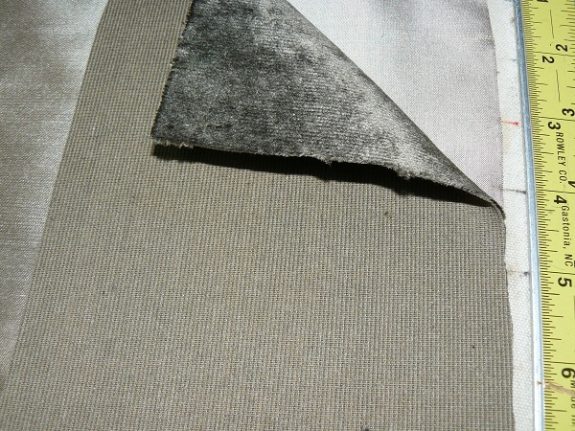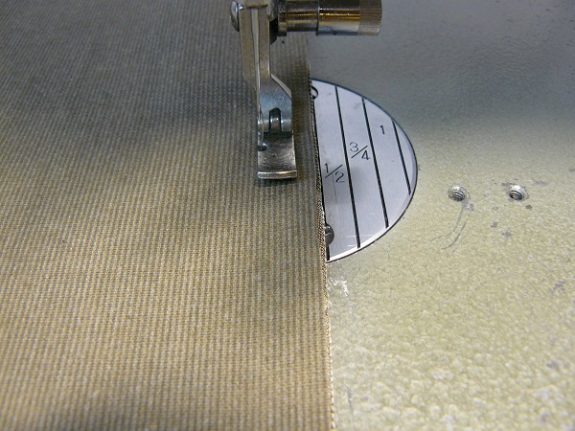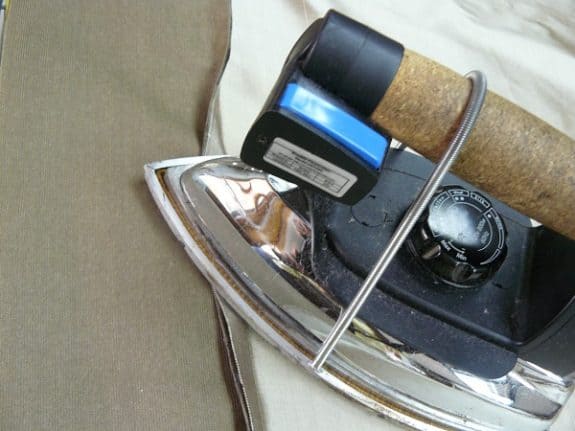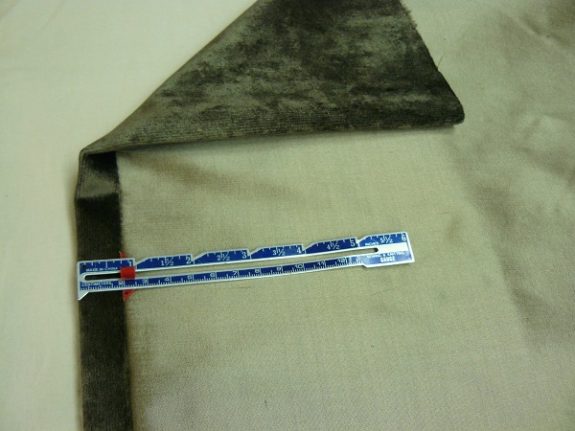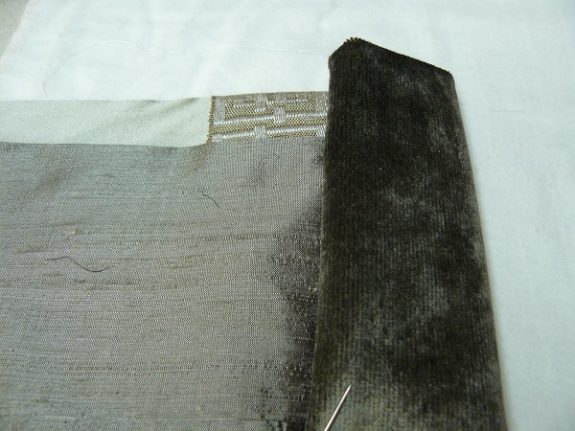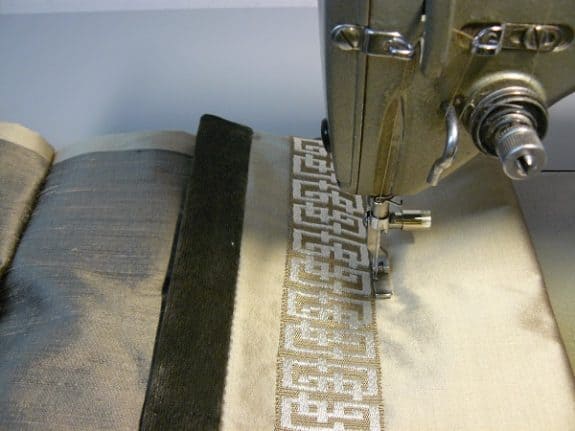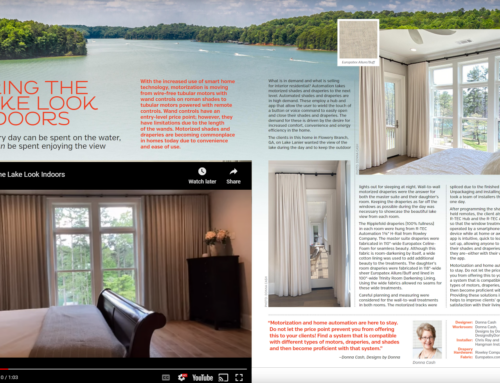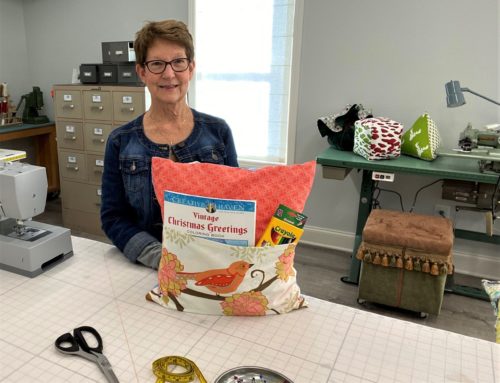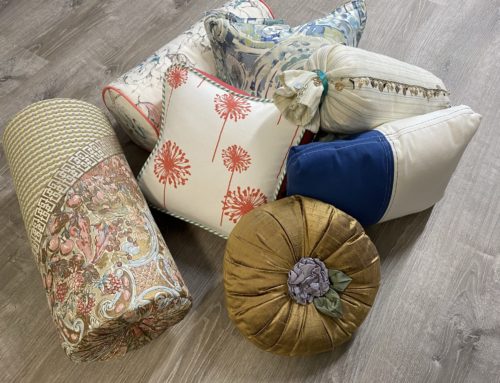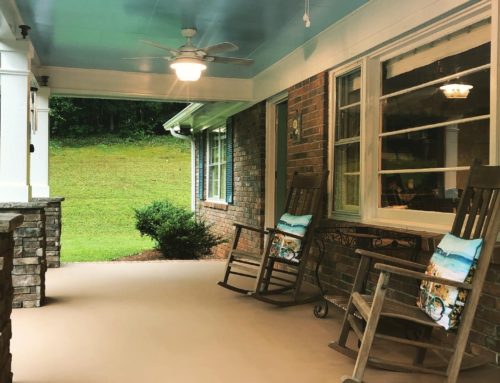Working with difficult fabrics can be challenging and stressful unless you first determine your course of action. This is the second edition of working with difficult fabrics. I’ll show you how I used upholstery weight silk velvet to make narrow bands on silk taffeta panels. Now these are two fabrics that couldn’t be more incompatible. However, as a workroom professional it’s my job to figure these things out when asked. And honestly, I love the challenge. In case you missed part one be sure to read it here. I showed how to work with matchbook pleated fabric to make a bed skirt.
This project called for drapery panels to be fabricated out of silk taffeta, so no problem there. The designer requested a one-half inch band on the lead edge of the drapery in a contrasting color fabric. No problem with that either. However, the contrasting fabric was an upholstery weight silk velvet. Yikes! You’ll see this panel also has Greek key flat braid. This post is about difficult fabrics so I’m not going to cover how I added the braid as it’s not difficult.

Upholstery weight silk velvet and silk taffeta are difficult fabrics to use together.
Communication is key for what I call a ‘no unhappy surprises at the installation’ so I collaborated with the designer on the requested details. I suggested the velvet band finishing at three quarters of an inch as I felt this was more attainable with this fabric than a one-half inch band and she was comfortable with this.
Here’s how I fabricated the band.
-
- Determine the band cut width – Cut the fabric for the band to include the band size + seam allowance (SA) + hem allowance, + allowance for turn of the cloth. Turn of the cloth is the amount of fabric that is taken up as the fabric turns. A very light weight fabric will have very little take up while a heavy fabric such as this silk velvet uses more fabric as it turns over. This may also be considered workroom allowance (WA). It’s difficult to know exactly how much to add for this so if in doubt, add a little more as it can always be removed but you cannot add more fabric if you have cut too little fabric.
- ¾” band + ½” SA + 3 + ¾” WA = 5” cut width for the band
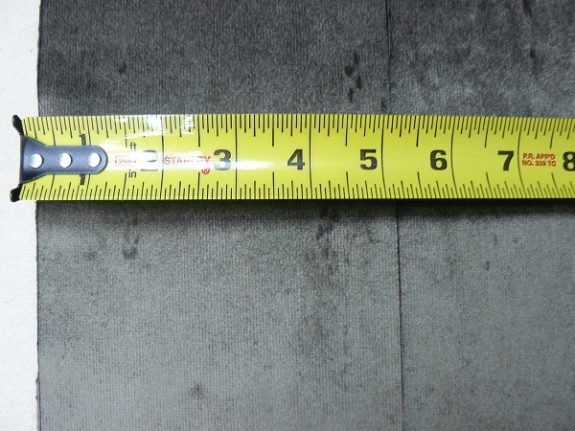
Determine the band cut width before marking and cutting your fabric.
- ¾” band + ½” SA + 3 + ¾” WA = 5” cut width for the band
- Cut the fabric bands – Cut the fabric bands for the lead edge of the drapery panel. Seams in the bands do not look good so enough fabric was ordered for the bands to be cut in one section for the entire length of the panel. I had four panels and could get all four bands out of one width of fabric, plus there was a little fabric from the bands left over. Layer the band over the panel fabric before stitching.
- Sew the bands to the lead edge of the panels – I stitched a one-half inch seam allowance with the band fabric on the top. This worked well for me but you may want to experiment with your fabrics to see which works best for you. It wouldn’t be wrong to sew with the drapery fabric on top of the band if you get better results sewing it this way. You’ll notice I don’t have pins as I like to hold my fabrics as I sew, but if you like to use pins, pin in the seam allowance, especially if you are using silk fabrics or other fabrics where pin holes will show in your fabric.
- Press the seam allowance towards the band – This will create an even band and the seam allowance inside the band will add volume to the band giving a luxurious look to the panel.
- Wrap the remaining band fabric to the back of the panel . – A one-half seam allowance was used, but the fabric band measures three quarters of an inch wide. Can you see how thick the fabric is as it turns over to the back of the panel? This shows a good example of the turn of the cloth I earlier mentioned.
- Adding the interlining and lining – Add the interlining and lining to the panel. Normally I fold the lining and interlining into the side hems. The weight of the band fabric was heavy enough to give me the volume I wanted. I cut the lining and interlining to end at the inside edge of the contrast band.
- Finishing the side hem – Finishthe bottom hem and heading of the panel. Fold the remaining side of the band all the way into the band. Hand stitch the band in place.
The last step for these panels includes sewing the pleats. In this photo you can see how nicely the band turned out. So you can see it is possible to join a heavy silk velvet with silk taffeta and attain beautiful results. Are you ready to try?
I want to help you become more confident in working with difficult fabrics. Leave comments and let me know of any fabrics you may need help with. Sign up for my newsletter and stay up to date on what I’m doing at here at Designs by Donna. Here’s a link to my page where you can sign up. https://designsbydonnaatlanta.com/seminars-classes/online-sewing-classes/
Check out my online sewing classes, videos, and PDF’s so you can take your sewing skills to the next level. https://designsbydonnaatlanta.com/seminars-classes/online-sewing-classes/
Happy sewing! Designs by Donna – Creating Joy Out of Passion
- Determine the band cut width – Cut the fabric for the band to include the band size + seam allowance (SA) + hem allowance, + allowance for turn of the cloth. Turn of the cloth is the amount of fabric that is taken up as the fabric turns. A very light weight fabric will have very little take up while a heavy fabric such as this silk velvet uses more fabric as it turns over. This may also be considered workroom allowance (WA). It’s difficult to know exactly how much to add for this so if in doubt, add a little more as it can always be removed but you cannot add more fabric if you have cut too little fabric.


